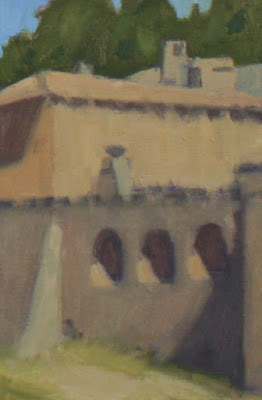 |
| (c) James Currin, 2016 |
One day during the recent workshop in Provence with Maggie Siner, we painted at the beautiful Abbaye Saint Hilaire. I found myself thinking a lot that day about how light and shadow appear on a structure that is situated in the landscape--and how very quickly those lights and shadows change! Maggie's remarks that day also stimulated me to think about building my composition around an interesting pattern of shapes, both dark and light, rather than simply illustrating the subject.
One of my takeaways from Maggie's lesson that day was to solve the big color blocks first. Only after doing that should I let myself move to smaller events or "details". I loved the way
that James Currin saw the Abbey (top painting), and I think he took some of these same points to heart. James' painting seemed almost abstract, and yet completely real. Beautiful, subtle shifts of color. Bob Dodson's painting, just above, was also lovely. I was taken by the cropping of his composition, which really brought the viewer into the heart of the scene. And Bob avoided getting bogged down in extraneous detail as well--beautiful! (I apologize for the quality of these images--they were taken in field conditions and are not very robust in resolution).
Sherrie Russ Levine took to the inside of the Abbey. She painted in the chapel itself, and came up with the beautiful painting above. So simple, and yet so powerful. And Stan Piotroski painted in the cloister (see his painting below). More wonderful arrangements of light and dark shapes. It all goes to show--at any given location, there will be as many different choices of subject as there are painters!
A bit of history, for those who like such things. Construction on Abbaye Saint Hilaire began in the 1200's. It was an active Carmelite abbey for centuries, but the Carmelite order waned over time. After the French Revolution, the abbey came into private hands. It eventually became a farm, fell into disarray, was subdivided, and was damaged further by an earthquake and severe weather. Thankfully, the Bride family purchased the property in 1961, and began the Herculean process of restoration. We are all most appreciative to Brides for their dedication to restoring this property, and for allowing us to visit. I will close with one of my own paintings from our morning there. Enjoy!
 |
| (c) Bob Dodson, 2016 |
that James Currin saw the Abbey (top painting), and I think he took some of these same points to heart. James' painting seemed almost abstract, and yet completely real. Beautiful, subtle shifts of color. Bob Dodson's painting, just above, was also lovely. I was taken by the cropping of his composition, which really brought the viewer into the heart of the scene. And Bob avoided getting bogged down in extraneous detail as well--beautiful! (I apologize for the quality of these images--they were taken in field conditions and are not very robust in resolution).
 |
| (c) Sherrie Russ Levine, 2016 |
A bit of history, for those who like such things. Construction on Abbaye Saint Hilaire began in the 1200's. It was an active Carmelite abbey for centuries, but the Carmelite order waned over time. After the French Revolution, the abbey came into private hands. It eventually became a farm, fell into disarray, was subdivided, and was damaged further by an earthquake and severe weather. Thankfully, the Bride family purchased the property in 1961, and began the Herculean process of restoration. We are all most appreciative to Brides for their dedication to restoring this property, and for allowing us to visit. I will close with one of my own paintings from our morning there. Enjoy!
 |
| (c) Lesley Powell, 2016 |

Gorgeous, I particularly loved the painting, that James did that day. It had an "alive " quality that I think I have seen in the works of Georgia O'Keefe.
ReplyDeleteI agree with you 100% about James' painting. Thanks for reading!
Delete